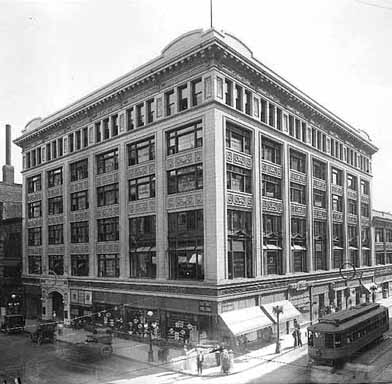Difference between revisions of "Bremer Arcade"
(table) |
|||
| Line 1: | Line 1: | ||
| − | [[Image:Svc_bremerarc.jpg]] | + | <div style="text-align: center;"> |
| + | '''419 Robert Street, St. Paul, MN''' | ||
| + | </div> | ||
| + | |||
| + | |||
| + | |||
| + | {| {{prettytable}} | ||
| + | ! | ||
| + | ! | ||
| + | |- | ||
| + | | [[Image:Svc_bremerarc.jpg]] | ||
| + | | An anchor in downtown St. Paul for 112 years, the Bremer Arcade was part of the capital city’s bustling downtown core. It shared the intersection of Robert Street and Seventh with three department stores (including the [[The Golden Rule/Emporium Department Stores]]) and the Ryan Hotel—St. Paul’s grandest. The structure was once a common component of American urban life—shopping arcades we precursors to contemporary shopping malls. The buildings offered several stories of professional offices, cafes, haberdashers, tailors, hairdressers, cigar stores, and small-scale medical offices. | ||
| + | |||
| + | |||
| + | As a nexus of downtown St. Paul’s commercial activity, the Bremer Arcade provided all of the necessary conditions for queer sexual activity among men. Like the surrounding department stores, the building was open for most of the day, it was a place of constant turnover, and it provided a small space for men in the know to clandestinely meet one another. | ||
| + | |} | ||
| + | |||
| + | |||
| + | |||
| + | |||
| + | |||
| + | |||
| + | |||
| + | Ricardo J. Brown recalled the Bremer Arcade as a part of St. Paul’s sexual underground in his book, The Evening Crowd at Kirmser’s: A Gay Life in the 1940s. He noted his “territory” as “some of the toilets in St. Paul,” including “the second-floor toilet in the Bremer Arcade across the street [from the Golden Rule], its massive, old, porcelain, floor-length urinals big enough to stand in.” The building’s plumbing fixtures added an interesting element of ease to cruising—without partitions, men could exhibit themselves with little fear of getting into trouble. | ||
| + | |||
| + | |||
| + | The arcade lasted longer than its neighbors and attracted business through the 1960s, 70s, and 80s. However, in 1992, the structure faced an unassailable opponent—The Mall of America, largest in the United States. The competition spelled doom for the Bremer and other shopping arcades in the Twin Cities. In 1997, the City of St. Paul demolished the building to make way for the Minnesota Mutual Life Insurance company’s 13-story headquarters. | ||
| + | |||
---- | ---- | ||
| Line 5: | Line 32: | ||
This page is still under construction. -SVC | This page is still under construction. -SVC | ||
| + | |||
Part of [[Minneapolis/St. Paul, MN: 100 Queer Places in Minnesota History, (1860-1969), (1969-2010)]] | Part of [[Minneapolis/St. Paul, MN: 100 Queer Places in Minnesota History, (1860-1969), (1969-2010)]] | ||
Revision as of 17:29, 21 March 2010
419 Robert Street, St. Paul, MN

|
An anchor in downtown St. Paul for 112 years, the Bremer Arcade was part of the capital city’s bustling downtown core. It shared the intersection of Robert Street and Seventh with three department stores (including the The Golden Rule/Emporium Department Stores) and the Ryan Hotel—St. Paul’s grandest. The structure was once a common component of American urban life—shopping arcades we precursors to contemporary shopping malls. The buildings offered several stories of professional offices, cafes, haberdashers, tailors, hairdressers, cigar stores, and small-scale medical offices.
|
Ricardo J. Brown recalled the Bremer Arcade as a part of St. Paul’s sexual underground in his book, The Evening Crowd at Kirmser’s: A Gay Life in the 1940s. He noted his “territory” as “some of the toilets in St. Paul,” including “the second-floor toilet in the Bremer Arcade across the street [from the Golden Rule], its massive, old, porcelain, floor-length urinals big enough to stand in.” The building’s plumbing fixtures added an interesting element of ease to cruising—without partitions, men could exhibit themselves with little fear of getting into trouble.
The arcade lasted longer than its neighbors and attracted business through the 1960s, 70s, and 80s. However, in 1992, the structure faced an unassailable opponent—The Mall of America, largest in the United States. The competition spelled doom for the Bremer and other shopping arcades in the Twin Cities. In 1997, the City of St. Paul demolished the building to make way for the Minnesota Mutual Life Insurance company’s 13-story headquarters.
This page is still under construction. -SVC
Part of Minneapolis/St. Paul, MN: 100 Queer Places in Minnesota History, (1860-1969), (1969-2010)